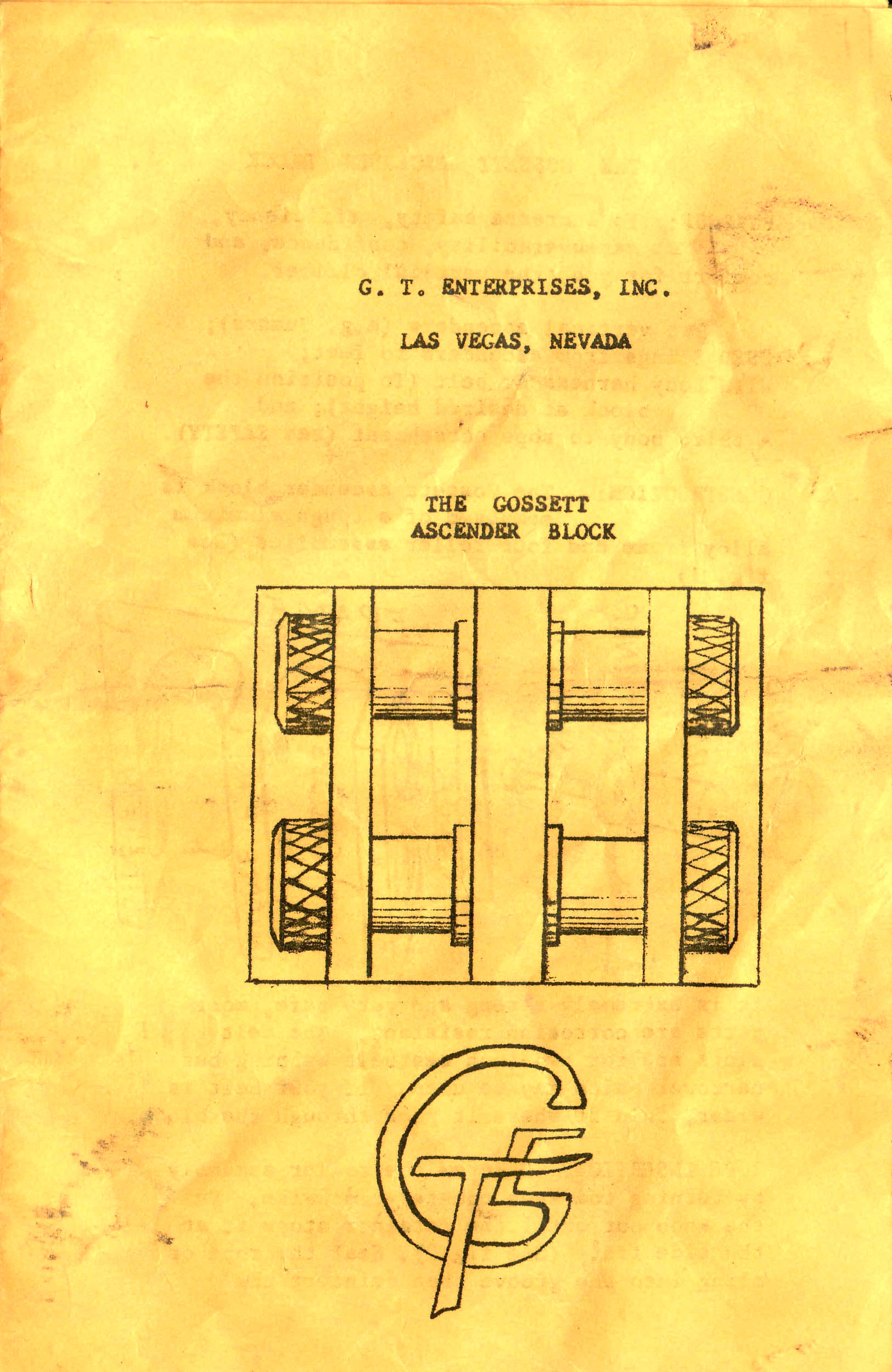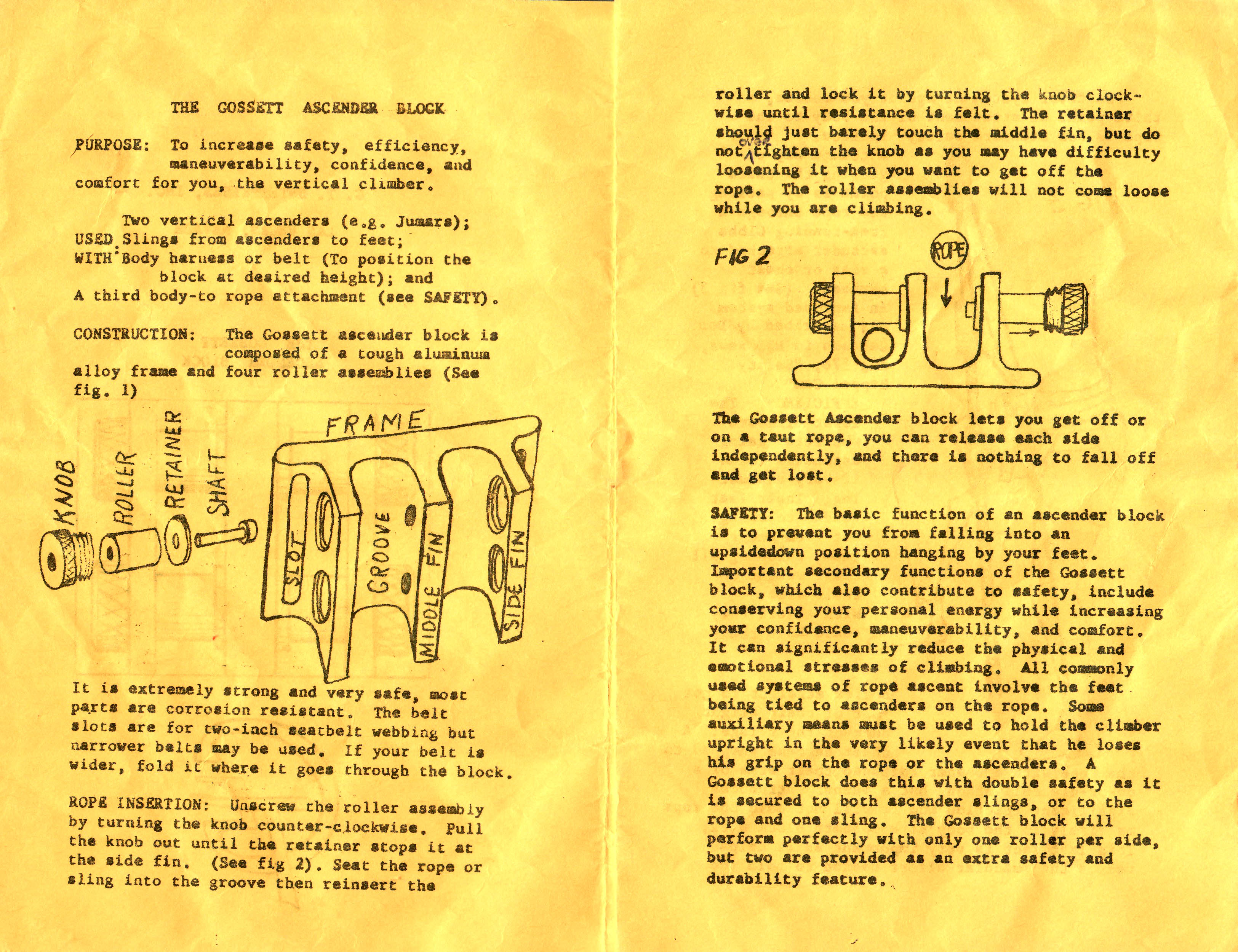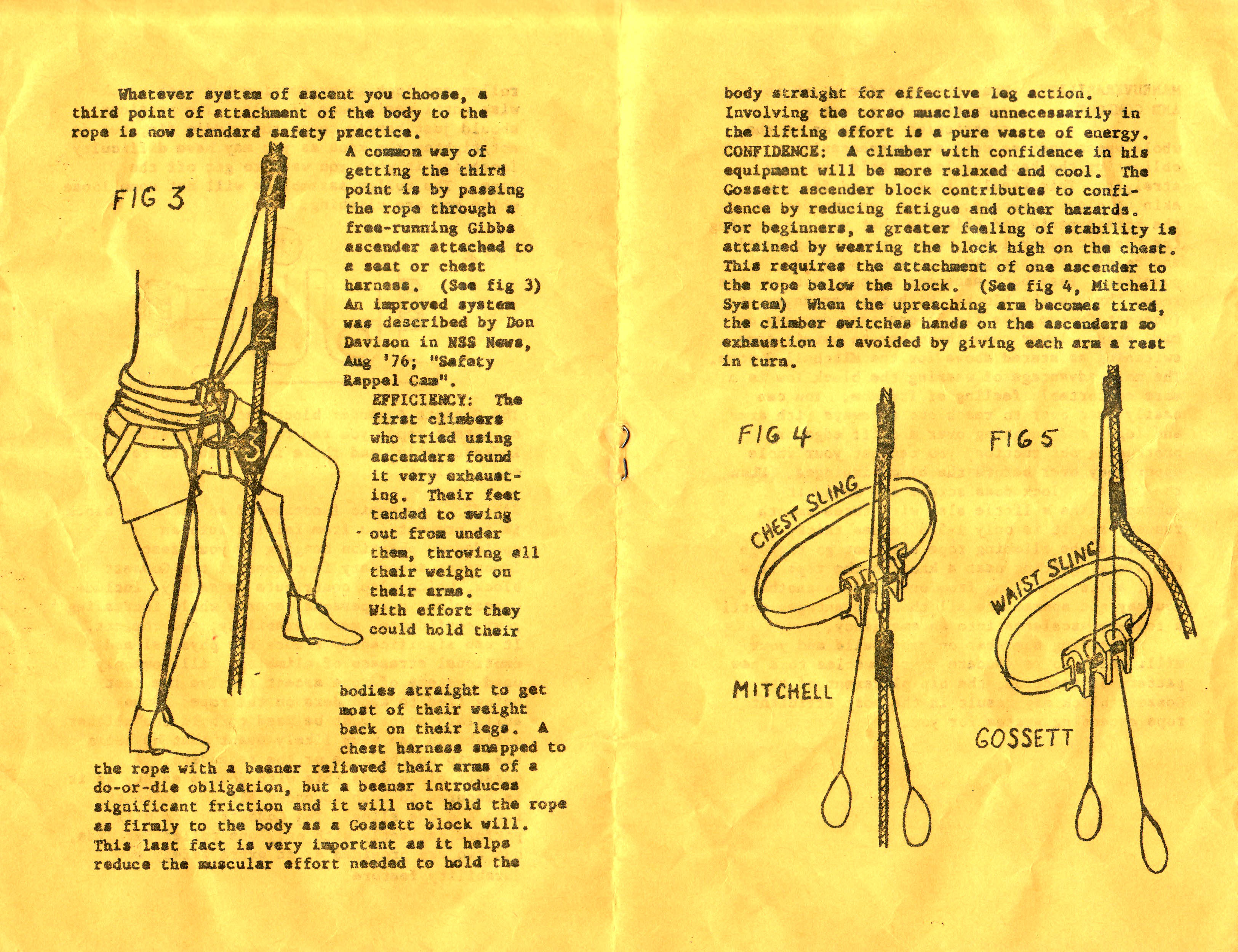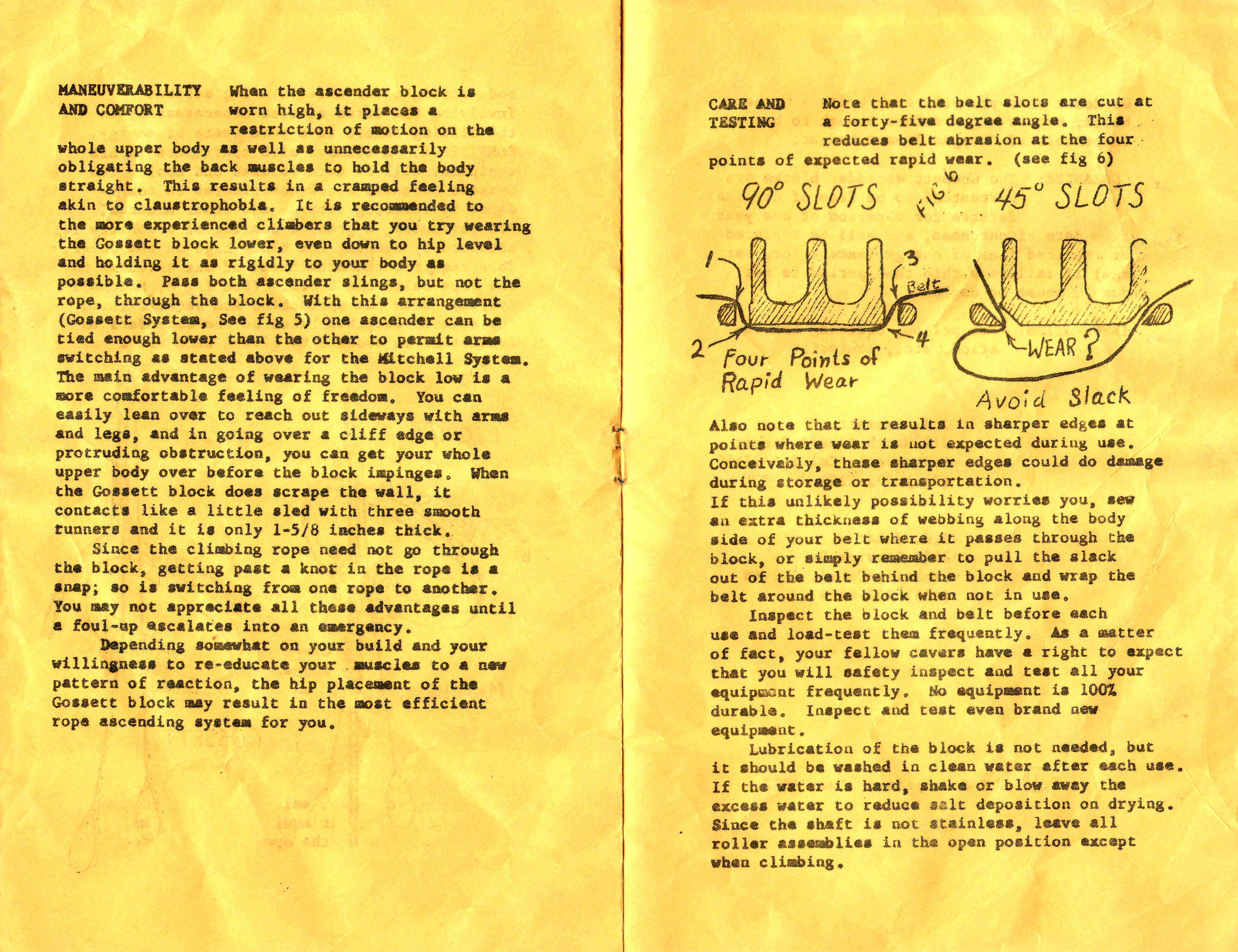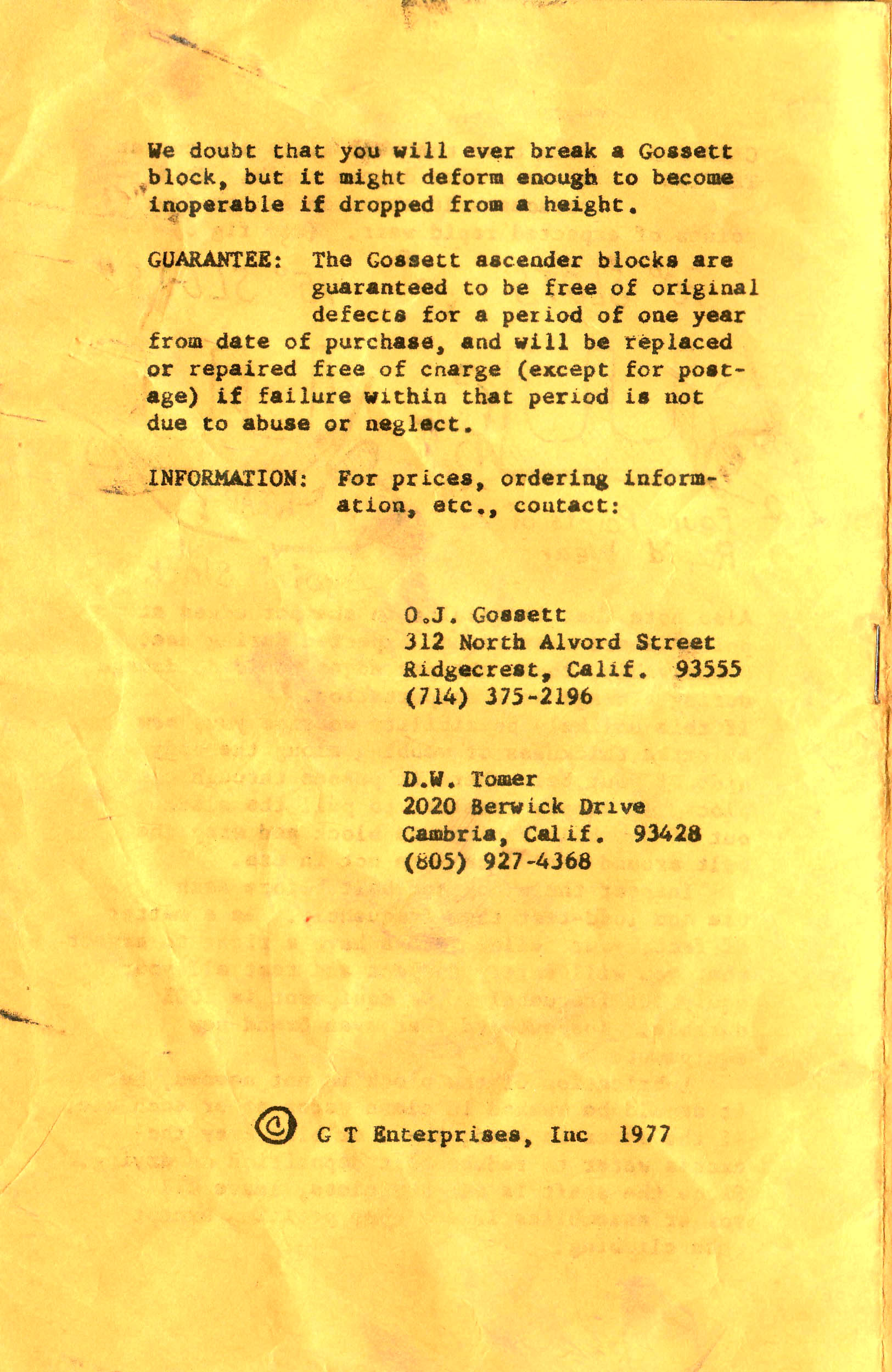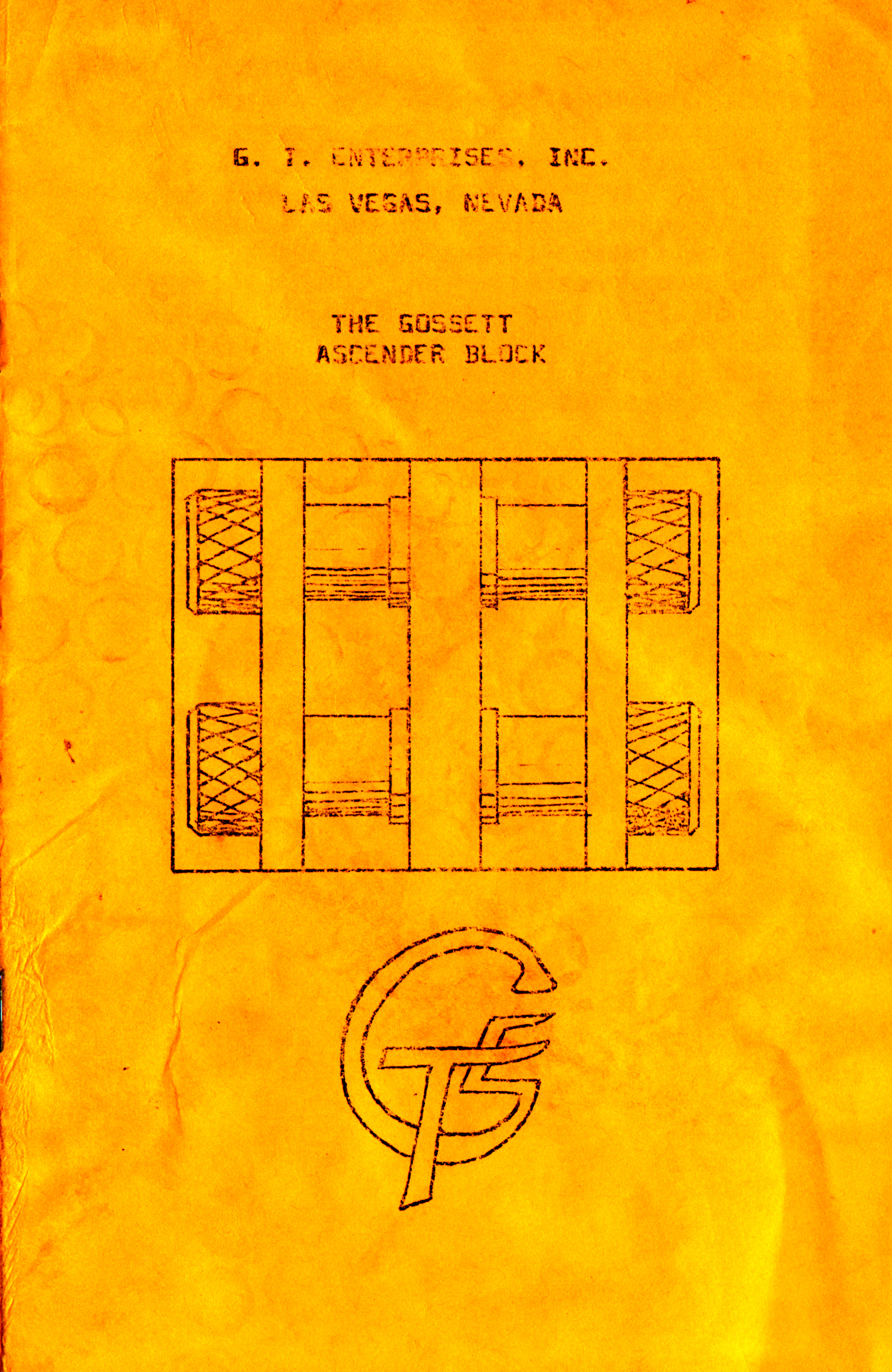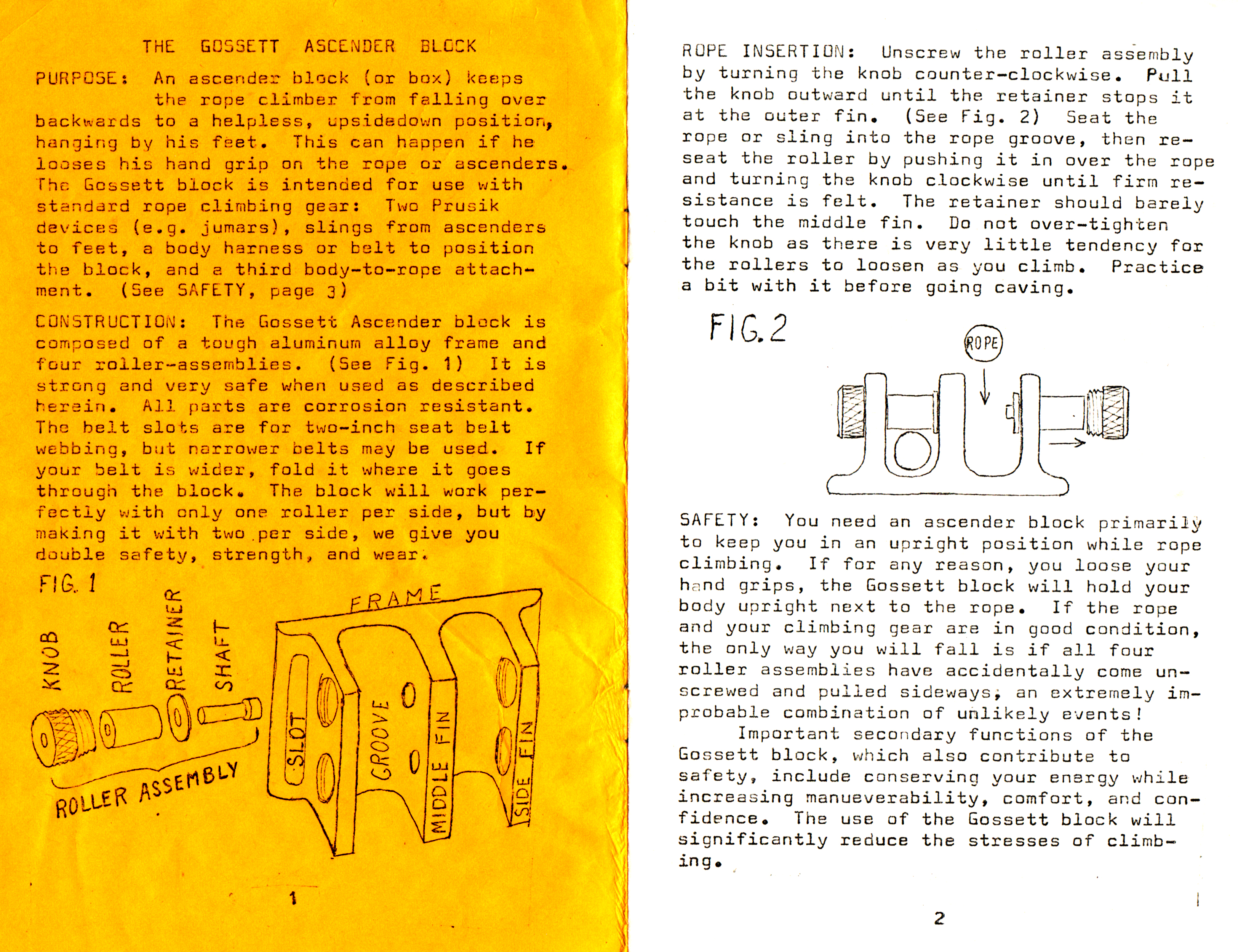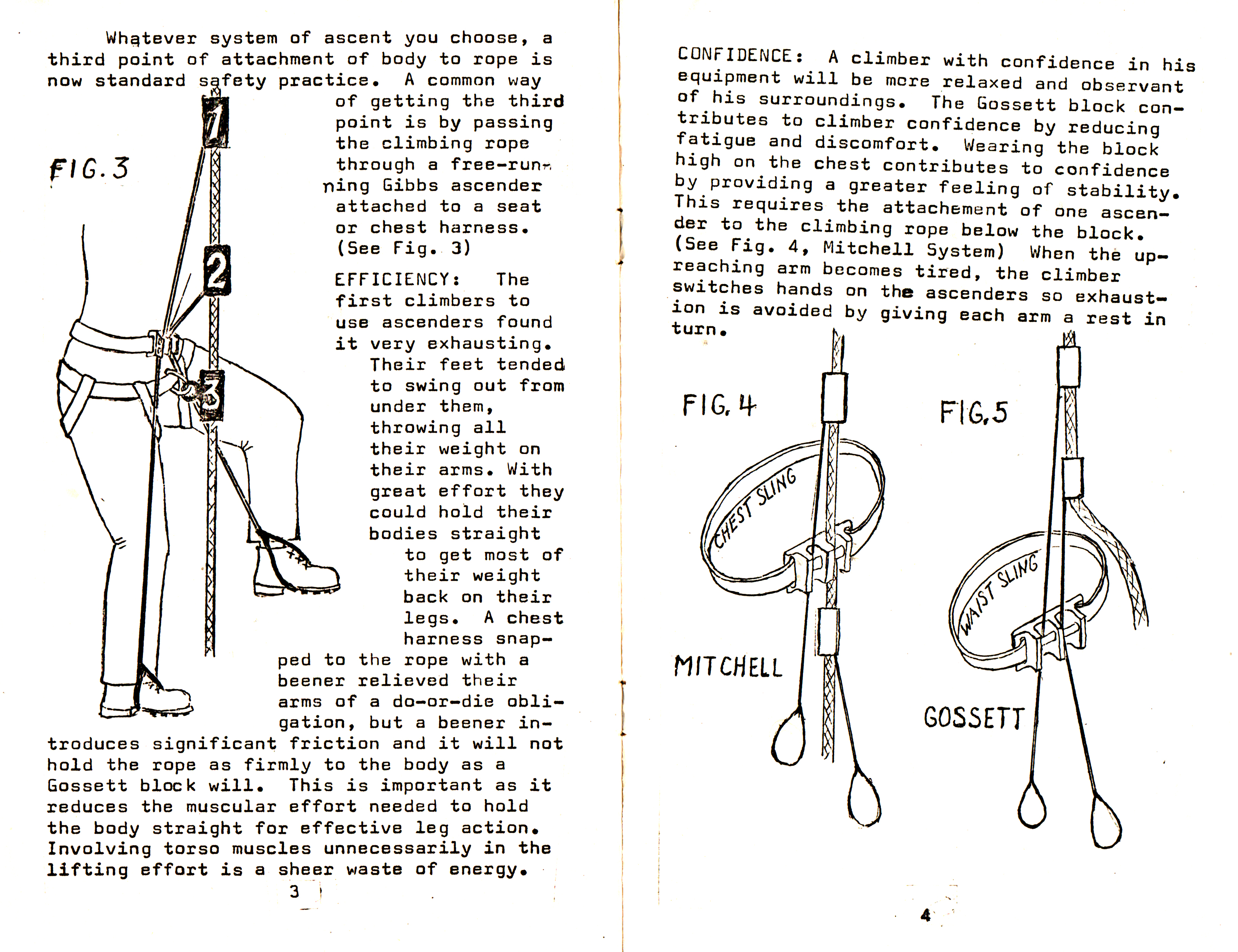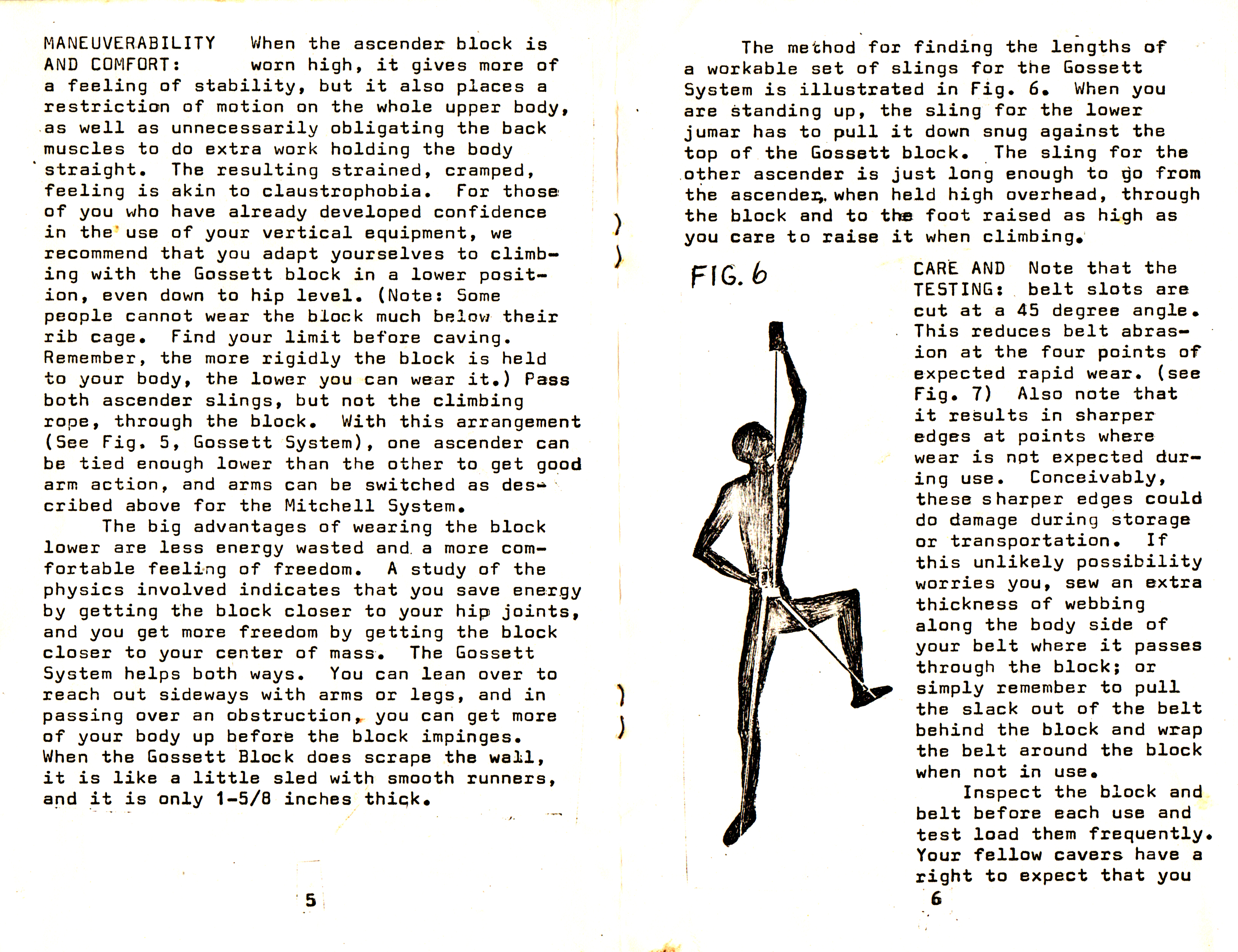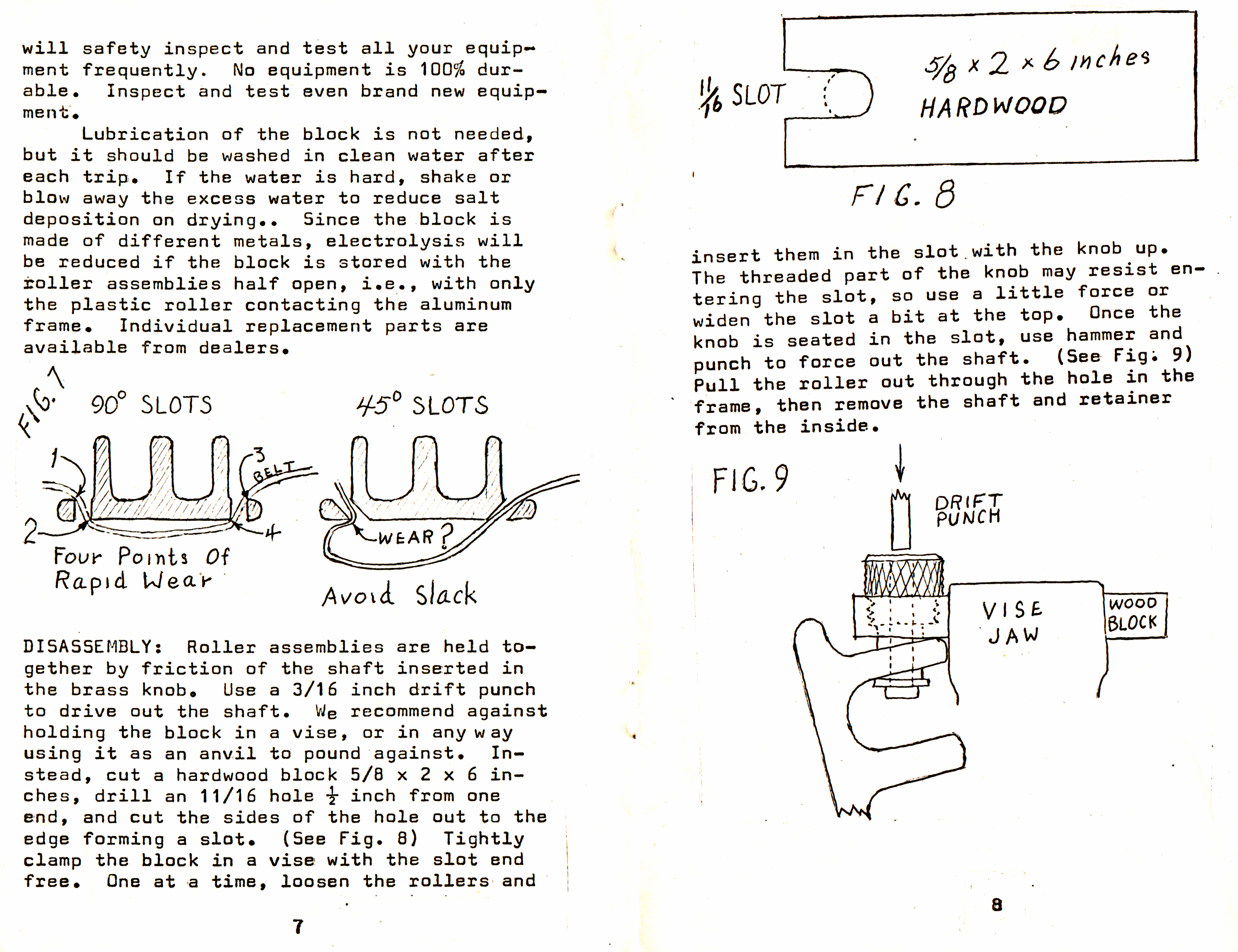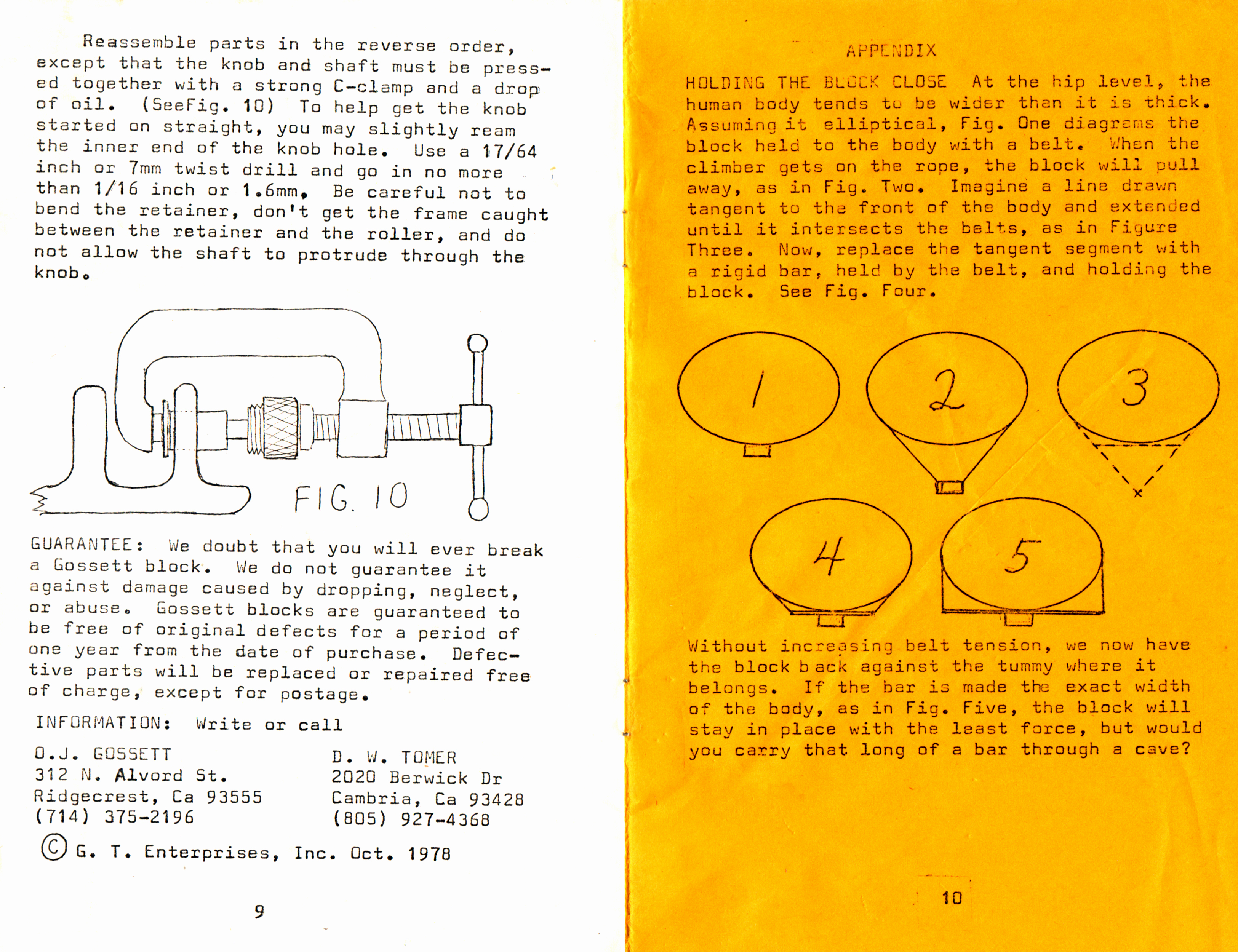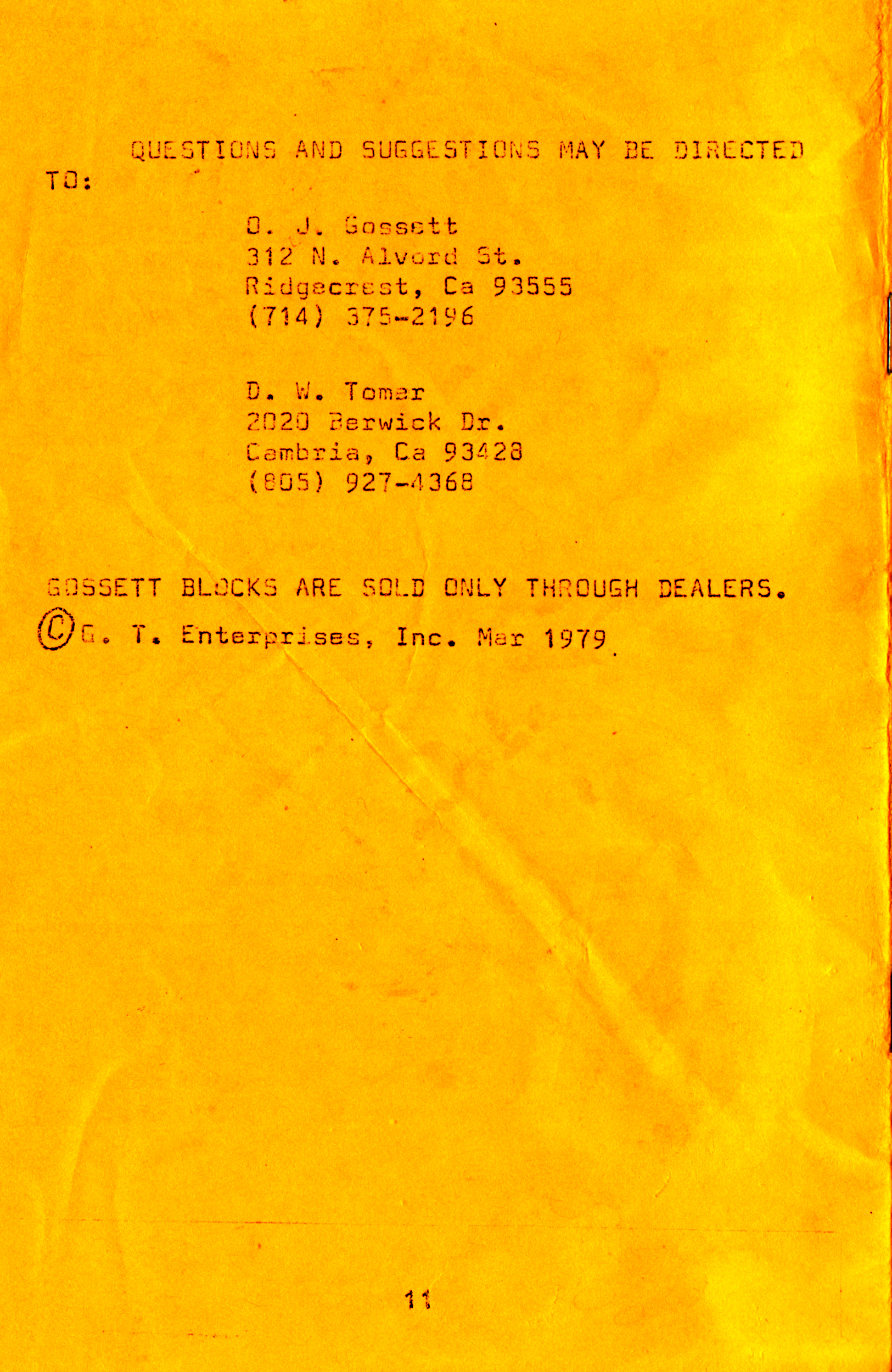Overview
History
After Keith Wilson’s invented the chest box to improve on Dick Mitchell’s racing system, he tried it in El Sótano de las Golondrinas and climbed out of the 333 m. pit in 33 minutes – still a respectable time. BlueWater soon introduced the first commercial ascender boxes. The BlueWater design was inexpensive and simple to make, but not easy to use. Cavers needed something better. In 1978 Maurice Neill invented his Neil Box. Although considered “the fourth best thing to come out of Ireland (after Guinness, women, and song),” it was not marketed in the U.S.A. We needed something better, and in 1978, Jim Gossett and Darrell Tomer introduced the Gossett Block.
The Gossett Blocks are made out of an aluminum extrusion, with two rollers on each side. The rollers are attached to pins set into knurled brass knobs which screw into the extrusion. The blocks have two angled vertical slots for attaching the box to a chest harness.
As with may commercial devices, the Gossett Block design evolved with time. Here is a summary of the production versions in my collection:
| Version |
Shell
Corners |
Mount |
Roller |
Retaining
Washers
|
Knob |
Knurl |
A
(#2655, 2747) |
Square |
Slots |
Nylon,
Cylindrical |
Plastic |
Narrow |
Male |
B
(#2707) |
Rounded |
C
(#1611, 2878) |
Square |
Brass |
Wide |
Female |
D
(#2841) |
Male |
E
(#1784, 2684, 3763) |
Delrin,
U-Groove |
F
(#2708) |
Hermaphrodite |
G
(#1833) |
Female |
H
(#634, 2601) |
Rounded |
I
(#2709) |
Square |
Screw
Holes |
In addition to the production versions, Darrel Tomer made quite a few custom variations.
Eventually, Jim and Darrell decided that they would no longer compete with the Simmons Roller, introduced in 1981 for a different application but later adapted for the Mitchell System. They sold their tooling and remaining components to Bob & Bob Bob. After Bob passed in 2017, I acquired the tooling and remaining components from his brother Bill. Since then, I’ve made some modified versions of my own, some based on some of Darrell’s earlier ideas.
I have two versions of the Gossett Block manual in my collection. The first, dating from 1977, came with my first block. That block was equivalent to Version A before I modified it.
Rich Kline sent me a newer manual in 2023. It dates from March, 1979. I do not have enough information to associate this manual with particular Gossett Block versions.
The instructions show the Gossett Block being used as part of the Gossett System. Due to safety issues, that system never became popular.
|
 |
Warning:
There
have been some incidents REQUIRING rescues with the Gossett System,
so just avoid it. |
 |
|
[ Top
| Version A (Mod.)
| Version B
| Version C
| Version D
| Version E
| Version F
| Version G
| Version H
| Version I
| Return to Chest Boxes
]
Version A
(#2655, 2747)
Technical Details
I acquired my first Gossett Block, Version A in 1978, but I modified it as described below. I acquired another in 2017 as part of Bob Thrun’s collection, and a third from Rick Banning at the 2019 NSS Convention.
Version A is 84 mm. wide, 64 mm. high, 41 mm.
thick, and weighs 328 g. The Gossett Block is made out of an
aluminum extrusion, with two rollers on each side. The rollers
are attached to pins set into knurled brass knobs which screw
into the extrusion. The block has two 48 mm. tall angled
vertical slots for attaching the box to a chest harness.
There are no markings on this box.
The Gossett Block was a state-of-the-art box in the late 1970s, but was soon replaced by other designs that were much lighter. I liked it, and continued using a modified version (Darrel Tomer’s #12) for some time.
Even with two rollers (perhaps an unnecessary redundancy, see,
for example, the variations), releasing
the rope is easier than on, say, the contemporaneous BlueWater
box.
[ Top
| Version A
| Version B
| Version C
| Version D
| Version E
| Version F
| Version G
| Version H
| Version I
| Return to Chest Boxes
]
Version A, Modified
(#633)
Technical Details
I acquired this Gossett Block, Version A in 1978, but I don't have
a record of from whom. I may have bought it directly from Darrel Tomer.
This version A is 84 mm. wide, 64 mm. high, 41 mm.
thick, and weighs 328 g. The Gossett Block is made out of an
aluminum extrusion, with two rollers on each side. The rollers
are attached to pins set into knurled brass knobs which screw
into the extrusion. The block has two 48 mm. tall angled
vertical slots for attaching the box to a chest harness.
There are no markings on this box.
I drilled the holes in the back of my box so that it could
be mounted on a Gossett
Plate for climbing with the Gossett System, an interesting
perversion where the box is mounted at belt level, and each foot
has an ascender on a long foot sling passing through the box.
This places the box near the caver’s center of gravity, making
it easy to flip upside-down.
|
 |
Warning:
There
have been some incidents REQUIRING rescues with the Gossett System,
so just avoid it. |
 |
|
[ Top
| Version A
| Version A (Mod.)
| Version C
| Version D
| Version E
| Version F
| Version G
| Version H
| Version I
| Return to Chest Boxes
]
Version B
(#2707)
Technical Details
I acquired my Version B block from Bill Liebman at the 2017 Old Timers Reunion.
My Gossett, Version B is 86 mm.
wide, 64 mm.
high, 41 mm.
thick, and weighs 328 g.
It is made out of an
aluminum extrusion, with two rollers on each side. The rollers
are attached to pins set into knurled brass knobs which screw
into the extrusion. The knobs have a male knurl. The block has two 48 mm. tall angled
vertical slots for attaching the box to a chest harness.
There are no markings on this box.
The corners are rounded, making the block more comfortable to handle.
This was one of Darrel Tomer’s blocks, and he engraved "D. W. Tomer" on the back.
[ Top
| Version A
| Version A (Mod.)
| Version B
| Version D
| Version E
| Version F
| Version G
| Version H
| Version I
| Return to Chest Boxes
]
Version C
(#1611, 2878)
Technical Details
I acquired Version C used on eBay from Gene Clinger in
2008. On Rope 1 donated another in 2021.
Version C is 85 mm. wide, 64 mm. high, 41 mm.
thick, and weighs 368 g. The block has two 48 mm. tall,
angled vertical slots for attaching the box to a chest harness.
The knobs on Version C are wider than those on Version A,
and the knurl was changed from a male to a female diamond knurl.
There are no markings on this box.
The larger knurls are easier to grip.
[ Top
| Version A
| Version A (Mod.)
| Version B
| Version C
| Version E
| Version F
| Version G
| Version H
| Version I
| Return to Chest Boxes
]
Version D
(#2841)
Technical Details
My Gossett Block, Version D has an interesting history that I'll discuss in the comments.
Version D is 85 mm. wide, 65 mm. high, 41 mm. thick, and weighs 365 g. It has the wider knobs of Version C but with a male knurl.
There are no markings on this box.
When they decided to discontinue producing the Gossett Block, Jim Gossett and Darrel Tomer sold the tooling and remaining components to Bob Liebman of Bob & Bob Enterprises. After Bob passed in 2017, I acquired these from his brother Bill. Soon after, my new job had me living away from home for a couple years.
It wasn't until 2021 that I started looking at the tooling in detail. Darrel left detailed instructions, but more to the point, he left a partially completed block in each of the jigs. Assembling the rollers was the last step in the process, and this block was used to illustrate the jig used to hold the block while press-fitting the knobs on the rollers. Three of the rollers were complete, and the final roller was started.
I finished pressing the knob onto the final roller, completing this block on May 9, 2021. So, in some sense and despite the early white nylon rollers, this is the last Gossett Block that Darrel made.
[ Top
| Version A
| Version A (Mod.)
| Version B
| Version C
| Version D
| Version F
| Version G
| Version H
| Version I
| Return to Chest Boxes
]
Version E
(#1784, 2684, 3763)
Technical Details
I acquired my first Gossett Block, Version E box from Charlotte Phillips in 2012, four more from Bob & Bob in 2017, and six more from Carol Veseley in 2022.
Version E is 86 mm. wide, 65 mm. high, 41 mm. thick, and weighs 370 g. The roller material was changed from nylon to delrin, and the rollers were shaped with an 11.8 mm. wide U-shape groove that reduces the 15.3 mm. diameter roller to a 13.6 mm. central diameter. The knobs have a male knurl.
There are no markings on this box.
The minor U-shaped groove in the rollers is not sufficient keep the rope centered; good technique is still required.
[ Top
| Version A
| Version A (Mod.)
| Version B
| Version C
| Version D
| Version E
| Version G
| Version H
| Version I
| Return to Chest Boxes
]
Version F
(#2708)
Technical Details
I acquired my Version F block from Bill Liebman at the 2017 Old Timers Reunion.
Version F is 86 mm. wide, 66 mm. high, 41 mm. thick, and weighs 372 g. It is made out of an
aluminum extrusion, with two rollers on each side. The rollers
are attached to pins set into knurled brass knobs which screw
into the extrusion. The block has two 48 mm. tall angled
vertical slots for attaching the box to a chest harness.
There are no markings on this box.
This one is interesting because the knobs on one side have male knurls and the knobs on the other have female knurls.
One knob was over-drilled for a good press fit, so it tends to fall off when the box is open. I need to stake it in place someday.
This was one of Darrel Tomer’s blocks, and he engraved "D. W. Tomer" on the back.
[ Top
| Version A
| Version A (Mod.)
| Version B
| Version C
| Version D
| Version E
| Version F
| Version H
| Version I
| Return to Chest Boxes
]
Version G
(#1833)
Technical Details
I acquired two Gossett, Version G blocks from James Thompson in 2014.
Version G is 85 mm. wide, 65 mm. high, 41 mm. thick, and weighs 376 g. It is a double channel chest box made out of an
aluminum extrusion, with two rollers on each side. The rollers
are attached to pins set into female-knurled brass knobs which screw
into the extrusion. The block has two 52 mm. tall angled
vertical slots for attaching the box to a chest harness.
There are no markings on this box.
This is probably the "normal" final form of the Gossett block.
[ Top
| Version A
| Version A (Mod.)
| Version B
| Version C
| Version D
| Version E
| Version F
| Version G
| Version I
| Return to Chest Boxes
]
Version H
(#634, 2601)
Technical Details
I acquired my Gossett Block, Version H from Speleoshoppe in 1982. I acquired another in 2017 as part of Bob Thrun’s collection.
Version H is 84 mm. wide, 64 mm. high, 41 mm.
thick, and weighs 367 g. The block has two 48 mm. tall,
angled vertical slots for attaching the box to a chest harness.
The corners of the frame were
rounded. The knobs have a female knurl.
There are no markings on this box.
The rounded corners were an improvement, but
in my mind, one of the variations that
never made it into production was superior.
[ Top
| Version A
| Version A (Mod.)
| Version B
| Version C
| Version D
| Version E
| Version F
| Version G
| Version H
| Return to Chest Boxes
]
Version I
(#2709)
Technical Details
I acquired my Version H block from Bill Liebman at the 2017 Old Timers Reunion.
My Gossett, Version H is 86 mm. wide, 66 mm. high, 41 mm. thick, and weighs 399 g. It is made out of an aluminum extrusion, with two rollers on each side. The rollers are attached to pins set into knurled brass knobs which screw into the extrusion. This block has four 5.6 mm. holes (one in each corner) instead of the usual angled slot.
There are no markings on this box.
The four holes are for attaching the block to a Gossett
Plate for climbing with the Gossett System.
|
 |
Warning:
There
have been some incidents REQUIRING rescues with the Gossett System,
so just avoid it. |
 |
|
[ Top
| Version A
| Version A (Mod.)
| Version B
| Version C
| Version D
| Version E
| Version F
| Version G
| Version H
| Version I
]



